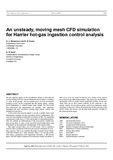- CERES Home
- →
- School of Engineering (SoE)
- →
- Staff publications (SoE)
- →
- View Item
JavaScript is disabled for your browser. Some features of this site may not work without it.
| dc.contributor.author | Richardson, G. A. | - |
| dc.contributor.author | Dawes, W. N. | - |
| dc.contributor.author | Savill, Mark A. | - |
| dc.date.accessioned | 2012-07-18T23:01:41Z | |
| dc.date.available | 2012-07-18T23:01:41Z | |
| dc.date.issued | 2007-03-01T00:00:00Z | - |
| dc.identifier.citation | G. A. Richardson, W. N. Dawes and A. M. Savill. An unsteady, moving mesh CFD simulation for Harrier hot-gas ingestion control analysis. The Aeronautical Journal, March 2007, pp.133-144 | - |
| dc.identifier.issn | 0001-9240 | - |
| dc.identifier.uri | http://dspace.lib.cranfield.ac.uk/handle/1826/2856 | |
| dc.description.abstract | Hot gas ingestion (HGI) can be a problematic feature of short take-off vertical landing (STOVL) aircraft during the descent phase of landing, or while on the ground. The hot exhaust gases from the downwards pointing nozzles can be re- ingested into the engine intakes, causing power degradation or reduced engine surge margin. The flow-fields that characterise this phenomenon are complex, with supersonic impinging jets and cross-flows creating large ground vortices and fountain up-wash flows. A flow solver has been developed to include a suitable linear mesh deformation technique for the descending aircraft configuration. The code has been applied to predict the occurrence of HGI, by simulating experimental results from a 1/15th scale model of a descending Harrier. This has enabled an understanding of the aerodynamic mechanisms that govern HGI, in terms of the near-field and far-field effects and their impact on the magnitude of temperatures at the engine intake. This paper presents three sets of CFD results. First a validation exercise shows predicted results from the twin-jet with intake in crossflow test-case. This is an unsteady Reynolds averaged Navier Stokes (URANS) solution for a static geometry (there is no moving mesh). This allows comparison with experiment. Secondly, a full descent phase URANS Spalart-Allmaras (SA) turbulence model calculation is done on an 8⋅5m cell mesh for half the flow domain of the Harrier model and test-rig without dams/strakes. This shows how the HGI flow mechanisms affect the engine intake temperature profiles, for the case where there are no flow control methods on the underside of the aircraft. Thirdly, the full descent phase URANS SA turbulence model calculation is done on a 22⋅4m cell mesh for the full flow domain of the Harrier model and test-rig, with the dam/strake geometry included in the structured mesh region. NOMENCLATURE ADF advanced data format ATV advanced technology viewer CFD computational fluid dynamics DARP Defence Aerospace Research Partnership DTI Department of Trade and Industry FOD foreign object debris hexa hexahedral HGI hot-gas ingestion HPCx high performance comp | en_UK |
| dc.language.iso | en_UK | - |
| dc.publisher | Royal Aeronautical Society | en_UK |
| dc.title | An unsteady, moving mesh CFD simulation for Harrier hot-gas ingestion control analysis | en_UK |
| dc.type | Article | - |
Files in this item
This item appears in the following Collection(s)
-
Staff publications (SoE) [603]
